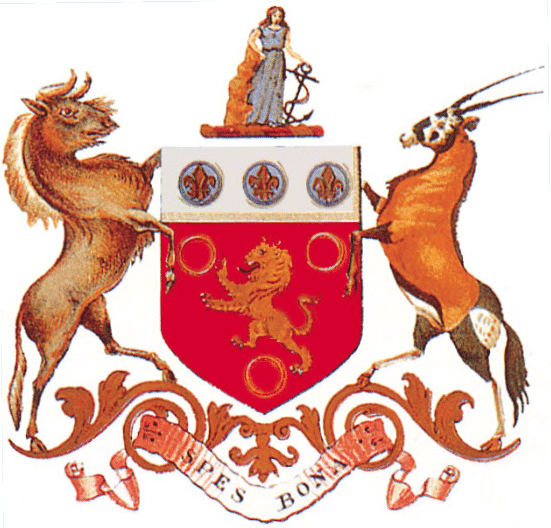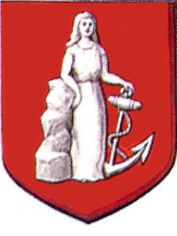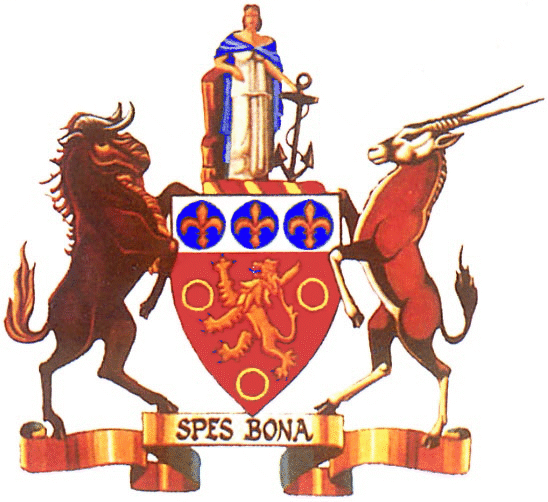

Cape of Good Hope Province (usually called Cape Province)
Provincie Kaap de Goede Hoop

The Cape Province continued to use the arms granted to the Cape of Good Hope Colony by Royal Warrant on 29 May 1876, the blazon of which reads:
Arms: Gules, a lion rampant between three Annulets Or, on a Chief Argent as many Hurts each charged with a fleur-de-lis of the second, for the Crest – on a Wreath of the Colours the Figure of Hope proper vested Azure resting the dexter arm on a Rock and supporting with the sinister hand an anchor sable entwined with a Cable also proper, and for Supporters – on the dexter side a Gnu and on the sinister side an Oryx (gems buck) both proper, together with the motto “SPES BONA”.
About the province:
The colony in its entirety formally became a province of the Union of South Africa on 31 May 1910. The Parliament building of the Cape Colony became the home of the Union Parliament (making Cape Town the legislative capital), and the province’s own legislature was called the Cape Provincial Council. The administration was headed by an Administrator appointed by the Governor-General with the advice of the Prime Minister, assisted by an Executive Committee whose members had to be elected members of the Provincial Council.
Heraldic developments:
 Arms were granted to the province by the College of Arms on 4 May 1911, in the form of the Cape quarter of the Union arms, but the arms so granted were not even communicated to the province (see Union of South Africa) and, despite the technical invalidity of the 1876 grant, this continued in use, even after the contents of the 1911 warrant became known to the provincial administration in 1937.
Arms were granted to the province by the College of Arms on 4 May 1911, in the form of the Cape quarter of the Union arms, but the arms so granted were not even communicated to the province (see Union of South Africa) and, despite the technical invalidity of the 1876 grant, this continued in use, even after the contents of the 1911 warrant became known to the provincial administration in 1937.
On 19 October 1928 the colonial arms replaced the royal arms on the masthead of the Province of the Cape of Good Hope Official Gazette.
In October 1948 the Executive Committee resolved to adopt the arms of the 1911 grant, with Van Riebeeck’s ship as a crest and retaining the wildebeest and gemsbok supporters, but nothing came of this.
Name of the province:
Since the Union’s official languages were English and Dutch, the province was also known as Kaap de Goede Hoop. This changed in 1925, when Afrikaans attained recognition, and the usual form became Kaap die Goeie Hoop. Already in 1914 Afrikaans had been acknowledged as a medium of instruction in schools.
Cape of Good Hope Province (Cape Province)
Provinsie Kaap die Goeie Hoop

Background to the drawing of 1950:
State Herald F G Brownell writes: “In 1950 the Secretary for the Interior took up the question of the provincial arms with the Prime Minister and each of the Provinces was asked to indicate which arms they desired to adopt. This brought the matter to a head and on 24 November 1950 the Cape Executive Committee resolved ‘that . . . Resolution No 1414 dated 19 October 1948, be rescinded and the Secretary for External Affairs be advised that the Executive Committee now desires that the Royal assent be sought for the recognition of the coat of arms promulgated in the Government Gazette of the Cape Colony, No 5609 dated 1st September 1876, and as altered in accordance with the coloured design submitted, with tails of the Gnu and the oryx upwards instead of hanging down, as the official coat of arms of the Cape Province’.
“The amended drawing of the arms was the work of Prof C S Groves.” There is just one significant change, which is mentioned in the blazon below.
“In February 1952 the College of Arms indicated that it could see no objection to the re-adoption of the arms in this form, and since 9 May 1952 this version has appeared on the front page of the Official Gazette of the Cape Province.”
In 1954 the Administrators of the four provinces were notified: “. . . Her Majesty the Queen has approved, formally, the withdrawal, with effect from the 22nd June, 1954, of the Royal Warrant of the 4th May 1911, in terms of which certain Coats of Arms were granted to the Provinces. Those Provinces which have not, as yet, done so, are now, at liberty to use the Coat of Arms which they desire to adopt.”
Following the promulgation of the Heraldry Act of 1962, the arms of the Cape Province were registered with the State Herald under certificate of registration No 99, issued on 30 October 1967. The blazon reads:
Arms: Gules, a lion rampant Or armed and langued azure between three annulets Or; on a chief Argent three hurts, each charged with a fleur-de-lis Or.
Crest: The Figure of Hope vested Argent mantled Azure, resting the dexter arm on a rock and supporting with the sinister hand an anchor Sable, cabled proper.
Wreath: Or and Gules.
Supporters: Dexter a black wildebeest and sinister a gemsbok, proper.
Motto: SPES BONA.
The only noticeable differences are firstly the colour of the lady Hope’s clothing (she is now dressed in white with a blue mantle, instead of being dressed in blue), and that the colour of the lion’s claws and tongue are specified. It is a convention of British heraldry that a red lion, or a lion on a red background, has blue claws and tongue, without its being specifically mentioned in the blazon.
Territorial and constitutional changes:
On 1 October 1922 Walvis Bay was – for all practical purposes – handed over to the administration of the Mandated Territory of South West Africa (formed in January ’21), although in terms of international law it remained part of South Africa and the Cape Province. On 30 August 1977 the Cape Province again became responsible for the administration of Walvis Bay.
Following the independence of Namibia in 1990, Windhoek requested two border adjustments: the handing over of Walvis Bay and the shifting of the Orange River border. In the end nothing was done about the river boundary, but Walvis Bay was handed over on 1 March 1994.
The Cape Province included tribal trust lands in its eastern parts and in the far north which under the policy of grand apartheid were earmarked for “homelands” or “Bantustans” and in the late 1970s and early ’80s became “independent” states – attaining a status recognised by South Africa but by no other country, even though the postage stamps issued by these states were accepted in many countries. These comprised the Xhosa-speaking territories of the Eastern Cape and the Tswana-speaking areas of the far Northern Cape.
Transkei, stretching from the Kei River to the Mtamvuna at the Natal border, was the first to take its independence, on 26 October 1976. This block of territory separated Griqualand East (magisterial district of Mount Currie, including the towns Kokstad and Matatiele) from the rest of the Cape Province, and the two districts were transferred to Natal. Despite provisions in the Constitution for changes in provincial boundaries to be approved by the provinces, this transfer was effected by the central government without consultation.
Bophuthatswana, which comprised isolated blocks of territory scattered across the far Northern Cape and in two other provinces, took its independence on 6 December 1977.
Ciskei, stretching from the Fish River to the outskirts of East London and northwards almost to Queenstown, became “independent” on 4 December 1981.
Under the 1984 Constitution the Provincial Council was abolished. The Administrator, now a presidential appointee (the prerogative having passed to the State President in 1961), now co-opted his Executive Committee instead of drawing it from elected legislators. The ostensible aim of this change was to broaden the base of the provincial administration to include people of other races (only whites had in practice been members of the Provincial Council, although other races were in theory not excluded), but by and large those appointed were lackeys of President P W Botha.
The end of apartheid in 1994 also meant the end of the Cape Province, which was split four ways: into the Western Cape (capital Cape Town) and the Northern Cape (capital Kimberley), which were unaffected by “homeland” states, and the Eastern Cape and North-West Province, which incorporated part or all of the three “independent” states previously cut out of the Cape Province.

Comments, queries: Mike Oettle